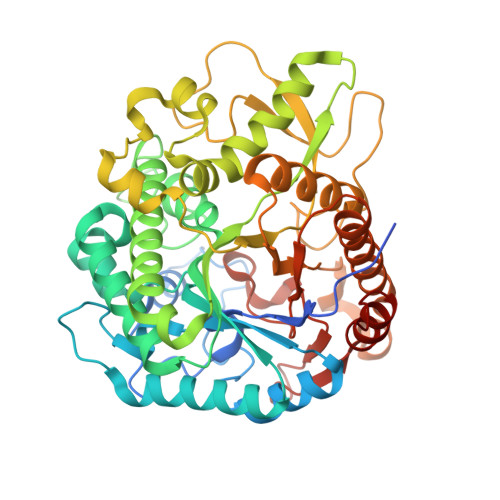Structural basis for glucose tolerance in GH1 beta-glucosidases.
Giuseppe, P.O., Souza, T.A.C.B., Souza, F.H.M., Zanphorlin, L.M., Machado, C.B., Ward, R.J., Jorge, J.A., Furriel, R.P.M., Murakami, M.T.(2014) Acta Crystallogr D Biol Crystallogr 70: 1631-1639
- PubMed: 24914974
- DOI: https://doi.org/10.1107/S1399004714006920
- Primary Citation of Related Structures:
4MDO, 4MDP - PubMed Abstract:
Product inhibition of β-glucosidases (BGs) by glucose is considered to be a limiting step in enzymatic technologies for plant-biomass saccharification. Remarkably, some β-glucosidases belonging to the GH1 family exhibit unusual properties, being tolerant to, or even stimulated by, high glucose concentrations. However, the structural basis for the glucose tolerance and stimulation of BGs is still elusive. To address this issue, the first crystal structure of a fungal β-glucosidase stimulated by glucose was solved in native and glucose-complexed forms, revealing that the shape and electrostatic properties of the entrance to the active site, including the +2 subsite, determine glucose tolerance. The aromatic Trp168 and the aliphatic Leu173 are conserved in glucose-tolerant GH1 enzymes and contribute to relieving enzyme inhibition by imposing constraints at the +2 subsite that limit the access of glucose to the -1 subsite. The GH1 family β-glucosidases are tenfold to 1000-fold more glucose tolerant than GH3 BGs, and comparative structural analysis shows a clear correlation between active-site accessibility and glucose tolerance. The active site of GH1 BGs is located in a deep and narrow cavity, which is in contrast to the shallow pocket in the GH3 family BGs. These findings shed light on the molecular basis for glucose tolerance and indicate that GH1 BGs are more suitable than GH3 BGs for biotechnological applications involving plant cell-wall saccharification.
Organizational Affiliation:
Brazilian Biosciences National Laboratory, National Center for Research in Energy and Materials, CP 6192, 13083-970 Campinas-SP, Brazil.


















